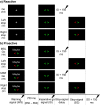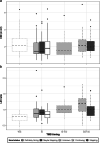Investigating the role of contextual cues and interhemispheric inhibitory mechanisms in response-selective stopping: a TMS study
- PMID: 36385251
- PMCID: PMC9925558
- DOI: 10.3758/s13415-022-01047-3
Investigating the role of contextual cues and interhemispheric inhibitory mechanisms in response-selective stopping: a TMS study
Abstract
Response-selective stopping requires cancellation of only one component of a multicomponent action. While research has investigated how delays to the continuing action components ("stopping interference") can be attenuated by way of contextual cues of the specific stopping demands ("foreknowledge"), little is known of the underlying neural mechanisms. Twenty-seven, healthy, young adults undertook a multicomponent stop-signal task. For two thirds of trials, participants responded to an imperative (go) stimulus (IS) with simultaneous button presses using their left and right index fingers. For the remaining one third of trials, the IS was followed by a stop-signal requiring cancellation of only the left, or right, response. To manipulate foreknowledge of stopping demands, a cue preceded the IS that informed participants which hand might be required to stop (proactive) or provided no such information (reactive). Transcranial magnetic stimulation (TMS) assessed corticospinal excitability (CSE) as well as short- and long-interval interhemispheric inhibition (SIHI, LIHI) between the primary motor cortices. Proactive cues reduced, but did not eliminate, stopping interference relative to the reactive condition. Relative to TMS measures at cue onset, decreases in CSE (both hands and both cue conditions) and LIHI (both hands, proactive condition only) were observed during movement preparation. During movement cancellation, LIHI reduction in the continuing hand was greater than that in the stopping hand and greater than LIHI reductions in both hands during execution of multicomponent responses. Our results indicate that foreknowledge attenuates stopping interference and provide evidence for a novel role of LIHI, mediated via prefrontal regions, in facilitating continuing action components.
Keywords: Bayes; Inhibitory control; Interhemispheric inhibition; Response inhibition; Selective stopping; Transcranial magnetic stimulation.
© 2022. The Author(s).
Conflict of interest statement
The authors have no competing interests to declare that are relevant to the content of this article.
Figures



Similar articles
-
Proactive Interhemispheric Disinhibition Supports Response Preparation during Selective Stopping.J Neurosci. 2023 Feb 8;43(6):1008-1017. doi: 10.1523/JNEUROSCI.1712-22.2022. Epub 2023 Jan 6. J Neurosci. 2023. PMID: 36609455 Free PMC article.
-
Response bias reveals the role of interhemispheric inhibitory networks in movement preparation and execution.Neuropsychologia. 2022 Jan 28;165:108120. doi: 10.1016/j.neuropsychologia.2021.108120. Epub 2021 Dec 14. Neuropsychologia. 2022. PMID: 34915037
-
The role of interhemispheric communication during complete and partial cancellation of bimanual responses.J Neurophysiol. 2021 Mar 1;125(3):875-886. doi: 10.1152/jn.00688.2020. Epub 2021 Feb 10. J Neurophysiol. 2021. PMID: 33567982
-
Corticospinal excitability reductions during action preparation and action stopping in humans: Different sides of the same inhibitory coin?Neuropsychologia. 2024 Mar 12;195:108799. doi: 10.1016/j.neuropsychologia.2024.108799. Epub 2024 Jan 11. Neuropsychologia. 2024. PMID: 38218313 Review.
-
Towards Conceptual Clarification of Proactive Inhibitory Control: A Review.Brain Sci. 2022 Nov 29;12(12):1638. doi: 10.3390/brainsci12121638. Brain Sci. 2022. PMID: 36552098 Free PMC article. Review.
Cited by
-
Investigating the effects of age and conditioning stimulation intensity on SMA-M1 connectivity in younger, middle-aged, and older adults.Eur J Appl Physiol. 2025 Jul 21. doi: 10.1007/s00421-025-05904-0. Online ahead of print. Eur J Appl Physiol. 2025. PMID: 40689955
-
Proactive cues facilitate faster action reprogramming, but not stopping, in a response-selective stop signal task.Sci Rep. 2023 Nov 10;13(1):19564. doi: 10.1038/s41598-023-46592-0. Sci Rep. 2023. PMID: 37949974 Free PMC article.
References
-
- Bestmann, S., & Krakauer, J. W. (2015). The uses and interpretations of the motor-evoked potential for understanding behaviour. In Experimental Brain Research. 10.1007/s00221-014-4183-7 - PubMed
Publication types
MeSH terms
LinkOut - more resources
Full Text Sources

